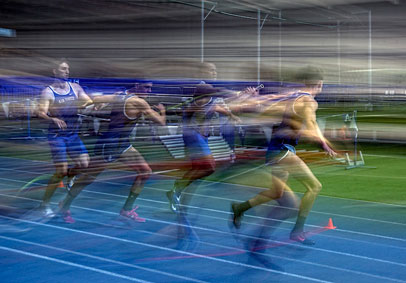Imagery is a skill that can help optimize your total fitness, including your physical and mental performance, nutrition, and relationship goals. It’s a way of purposefully using your senses—sight, sound, taste, smell, and touch—and your imagination to visualize how you want to perform a skill or task. Your brain automatically tends to think in images, so imagery can help you execute tasks with greater consistency, regulate your thoughts and emotions, and stay on track with your goals. Here are some ways imagery can help support your total fitness.
Physical fitness
Tactical skill execution requires precision and accuracy, and imagery can help develop both when it comes to your motor skills. Mental rehearsal can help you learn new physical skills and maintain (and even increase) your level of proficiency and consistency. When making adjustments on gross motor skills such as push-ups and sit-ups, external imagery works best when you picture yourself as an outside observer. Internal imagery, however, is seen from your own perspective, and it’s most helpful when you’re executing fine motor skills such as firing a weapon or inserting an intravenous (IV) line. Whether you’re practicing imagery as if you’re watching yourself on television or feeling each of your movements, both internal and external imagery can improve your performance in weight lifting, aerobic exercise (such as running, biking, and swimming), and speed and agility training.
Mental fitness
Try to use the power of your mind to imagine a better future for yourself and those around you, and help improve your overall sense of well-being. Your brain tends to cling to the negative, which benefits your ability to adapt and survive. However, negativity can lead to higher stress levels and poorer health. Still, training your brain to create vivid images of positive life events can help shift your negative views, boost your sense of hope—which can drive purposeful action—and even reduce your depression symptoms. Imagery also can help you better manage stressful situations, make contingency plans for obstacles you might face, and create moments of calm when needed.
Nutritional fitness
Imagery can help you stick to your healthy eating goals too. Cravings that can derail a healthy eating plan often involve thinking about the sight, smell, and taste of food. Visualizing food is strongly related to the vividness and force of your cravings because your senses engage and your desire to eat can intensify. However, you can lessen the strength of your cravings by redirecting your thoughts with imagery.
When food cravings strike, it might help to think of your favorite activity that’s not related to food. Picture yourself doing that activity. Focus on how your body moves, visualize the scene around you, and connect your senses to the activity. Doing so can help you resist food cravings and stay on the path to healthy eating.
Family fitness
Imagery also can bring calm during stressful family times because it promotes positive thinking that can help steady your emotions. Steadier feelings enable you to communicate more effectively with your loved ones, potentially reducing the amount of conflict at home.
If you’re pregnant, guided imagery can help decrease your stress levels during pregnancy and labor too. It can help normalize your heart rate and increase feelings of relaxation as well.
Couples who think of themselves as “highly stressed” also might benefit from guided imagery exercises during couples-therapy sessions. Imagery exercises can help you feel calmer and enjoy greater satisfaction within your relationship.
Debrief
There are many ways to include imagery in your total fitness arsenal—whether you’re mentally rehearsing physical skills, visualizing how to face obstacles, engaging your senses to ward off food cravings, or improving your communication with loved ones.
Learn how to use imagery for performance outcomes to boost your total fitness. Or read HPRC’s guide to writing your own imagery script, and try a guided imagery recording for relaxation.
